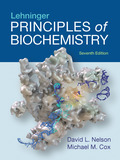
(a)
To calculate: The ratio
Introduction:
The ATP refers to adenosine triphosphate. A complex organic compound cell produces during the process of
(a)
Explanation of Solution
Calculation:
The equilibrium constant is equal to the ratio of
The value of gas constant R is 0.0083 kJ/mol K. The equilibrium constant is calculated as follows at the give temperature 293 K:
Conclusion:
The ratio
(b)
To calculate: The ratio of
Introduction:
The ATP refers to adenosine triphosphate. A complex organic compound cell produces during the process of cellular respiration. Cellular respiration is the process by which energy is produced in a cell. Energy is released from the breakdown of glucose in cellular respiration. This energy is then used by the cell for performing various life processes. Mitochondria are considered as the powerhouses of the cell, which synthesizes energy in the form of ATP..
(b)
Explanation of Solution
Calculation:
The two given
The value of
The value of gas constant R is 0.0083 kJ/mol K. The equilibrium constant is calculated as follows at the give temperature 293 K.:
Conclusion:
The ratio of
(c)
To calculate: The ratio of
Introduction:
The ATP refers to adenosine triphosphate. A complex organic compound cell produces during the process of cellular respiration. Cellular respiration is the process by which energy is produced in a cell. Energy is released from the breakdown of glucose in cellular respiration. This energy is then used by the cell for performing various life processes. Mitochondria are considered as the powerhouses of the cell, which synthesizes energy in the form of ATP.
(c)
Explanation of Solution
Calculation:
The value of
This above equation can be modified as following because the ratio
Conclusion:
The ratio of
Want to see more full solutions like this?
Chapter 13 Solutions
EBK LEHNINGER PRINCIPLES OF BIOCHEMISTR
- Calculate the pH and the pOH of each of the following solutions at 25 °C for which the substances ionize completely: (a) 0.000259 M HClO4arrow_forwardWhat is the pH of a 1.0 L buffer made with 0.300 mol of HF (Ka = 6.8 × 10⁻⁴) and 0.200 mol of NaF to which 0.160 mol of NaOH were added?arrow_forwardDetermine if the following salt is neutral, acidic or basic. If acidic or basic, write the appropriate equilibrium equation for the acid or base that exists when the salt is dissolved in aqueous solution. If neutral, simply write only NR. Be sure to include the proper phases for all species within the reaction. NaN₃arrow_forward
- A. Draw the structure of each of the following alcohols. Then draw and name the product you would expect to produce by the oxidation of each. a. 4-Methyl-2-heptanol b. 3,4-Dimethyl-1-pentanol c. 4-Ethyl-2-heptanol d. 5,7-Dichloro-3-heptanolarrow_forwardWhat is the pH of a 1.0 L buffer made with 0.300 mol of HF (Ka = 6.8 × 10⁻⁴) and 0.200 mol of NaF to which 0.160 mol of NaOH were added?arrow_forwardCan I please get help with this.arrow_forward
- Determine if the following salt is neutral, acidic or basic. If acidic or basic, write the appropriate equilibrium equation for the acid or base that exists when the salt is dissolved in aqueous solution. If neutral, simply write only NR. Be sure to include the proper phases for all species within the reaction. N₂H₅ClO₄arrow_forwardPlease help me with identifying these.arrow_forwardCan I please get help with this?arrow_forward
 ChemistryChemistryISBN:9781305957404Author:Steven S. Zumdahl, Susan A. Zumdahl, Donald J. DeCostePublisher:Cengage Learning
ChemistryChemistryISBN:9781305957404Author:Steven S. Zumdahl, Susan A. Zumdahl, Donald J. DeCostePublisher:Cengage Learning ChemistryChemistryISBN:9781259911156Author:Raymond Chang Dr., Jason Overby ProfessorPublisher:McGraw-Hill Education
ChemistryChemistryISBN:9781259911156Author:Raymond Chang Dr., Jason Overby ProfessorPublisher:McGraw-Hill Education Principles of Instrumental AnalysisChemistryISBN:9781305577213Author:Douglas A. Skoog, F. James Holler, Stanley R. CrouchPublisher:Cengage Learning
Principles of Instrumental AnalysisChemistryISBN:9781305577213Author:Douglas A. Skoog, F. James Holler, Stanley R. CrouchPublisher:Cengage Learning Organic ChemistryChemistryISBN:9780078021558Author:Janice Gorzynski Smith Dr.Publisher:McGraw-Hill Education
Organic ChemistryChemistryISBN:9780078021558Author:Janice Gorzynski Smith Dr.Publisher:McGraw-Hill Education Chemistry: Principles and ReactionsChemistryISBN:9781305079373Author:William L. Masterton, Cecile N. HurleyPublisher:Cengage Learning
Chemistry: Principles and ReactionsChemistryISBN:9781305079373Author:William L. Masterton, Cecile N. HurleyPublisher:Cengage Learning Elementary Principles of Chemical Processes, Bind...ChemistryISBN:9781118431221Author:Richard M. Felder, Ronald W. Rousseau, Lisa G. BullardPublisher:WILEY
Elementary Principles of Chemical Processes, Bind...ChemistryISBN:9781118431221Author:Richard M. Felder, Ronald W. Rousseau, Lisa G. BullardPublisher:WILEY





